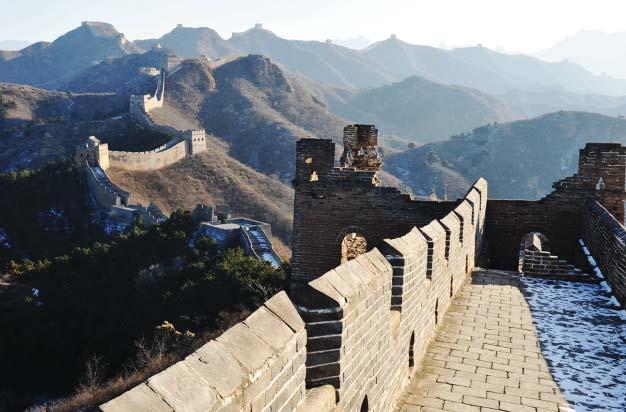AdvancedConcrete Technology
HongyanMa
ZongjinLi
XiangmingZhou
DongshuaiHou
Thisbookisprintedonacid-freepaper. ♾
Copyright©2023byJohnWiley&Sons,Inc.Allrightsreserved
PublishedbyJohnWiley&Sons,Inc.,Hoboken,NewJersey
PublishedsimultaneouslyinCanada
Nopartofthispublicationmaybereproduced,storedinaretrievalsystem,ortransmittedinanyformorbyanymeans, electronic,mechanical,photocopying,recording,scanning,orotherwise,exceptaspermittedunderSection107or108 ofthe1976UnitedStatesCopyrightAct,withouteitherthepriorwrittenpermissionofthePublisher,orauthorization throughpaymentoftheappropriateper-copyfeetotheCopyrightClearanceCenter,222RosewoodDrive,Danvers,MA 01923,(978)750-8400,fax(978)646-8600,oronthewebat www.copyright.com.RequeststothePublisherfor permissionshouldbeaddressedtothePermissionsDepartment,JohnWiley&Sons,Inc.,111RiverStreet,Hoboken, NJ07030,(201)748-6011,fax(201)748-6008,oronlineat www.wiley.com/go/permissions.
LimitofLiability/DisclaimerofWarranty:Whilethepublisherandauthorhaveusedtheirbesteffortsinpreparingthis book,theymakenorepresentationsorwarrantieswiththerespecttotheaccuracyorcompletenessofthecontentsofthis bookandspecificallydisclaimanyimpliedwarrantiesofmerchantabilityorfitnessforaparticularpurpose.Nowarranty maybecreatedorextendedbysalesrepresentativesorwrittensalesmaterials.Theadviceandstrategiescontained hereinmaynotbesuitableforyoursituation.Youshouldconsultwithaprofessionalwhereappropriate.Neitherthe publishernortheauthorshallbeliablefordamagesarisingherefrom.
Forgeneralinformationaboutourotherproductsandservices,pleasecontactourCustomerCareDepartmentwithinthe UnitedStatesat(800)762-2974,outsidetheUnitedStatesat(317)572-3993orfax(317)572-4002.
Wileypublishesinavarietyofprintandelectronicformatsandbyprint-on-demand.Somematerialincludedwith standardprintversionsofthisbookmaynotbeincludedine-booksorinprint-on-demand.Ifthisbookreferstomedia suchasaCDorDVDthatisnotincludedintheversionyoupurchased,youmaydownloadthismaterialat http://booksupport.wiley.com.FormoreinformationaboutWileyproducts,visit www.wiley.com
LibraryofCongressCataloging-in-PublicationDataAppliedfor
ISBN:9781119806257(Hardcover)
ISBN:9781119806202(ePDF)
ISBN:9781119806196(ePUB)
CoverDesign:Wiley
CoverImage:©graemenicholson/GettyImage
Tostudents,teachers,researchers,andengineersinthefieldofconcrete,whoarethedriving forcesforthedevelopmentofthescienceandtechnologyofconcrete,includingthepersonnel workingontheChina973project,BasicStudyonEnvironmentallyFriendlyContemporary Concrete(2009CB623200)
CONTENTS
Preface xi
1IntroductiontoConcrete1
1.1ConcreteDefinitionandHistoricalDevelopment1
1.2ConcreteasaStructuralMaterial7
1.3CharacteristicsofConcrete11
1.4TypesofConcrete14
1.5FactorsInfluencingConcreteProperties18
1.6ApproachestoStudyConcrete21 DiscussionTopics23 References23
2MaterialsforMakingConcrete25
2.1AggregatesforConcrete25
2.2CementitiousBinders38
2.3Admixtures86
2.4Water98 DiscussionTopics101 Problems102 References103
3FreshConcrete109
3.1Introduction109
3.2WorkabilityandRheology109
3.3MixDesign124
3.4ManufactureofConcrete149
3.5DeliveryofConcrete150
3.6ConcretePlacing152
3.7CuringofConcrete160
3.8Early-AgePropertiesofConcrete164
DiscussionTopics166
Problems167
References168
4MaterialsStructureofConcrete171
4.1Introduction171
4.2ClassificationofMaterialsStructuralLevels172
4.3StructureofConcreteatNanometerScale:TheC–S–HStructure176
4.4StructureofConcreteattheMicro-Scale191
4.5TheTransitionZoneinConcrete194
4.6Nano-andMicro-StructuralEngineering198
DiscussionTopics208
References209
5PropertiesofHardenedConcrete213
5.1StrengthsofHardenedConcrete213
5.2Stress–StrainRelationshipandConstitutiveEquations238
5.3DimensionalStability—ShrinkageandCreep246
5.4Durability265
DiscussionTopics297
Problems298 References299
6AdvancedCementitiousComposites305
6.1Fiber-ReinforcedCementitiousComposites305
6.2High-StrengthCementitiousComposites324
6.3Ultra-High-StrengthConcrete331
6.4PolymersinConcrete336
6.5Shrinkage-CompensatingConcrete347
6.6Self-CompactingConcrete350
6.7EngineeredCementitiousComposite364
6.8ConfinedConcrete366
6.9High-VolumeFlyAshConcrete369
6.10StructuralLightweightandHeavyweightConcrete371
6.11SeaSandandSeaWaterConcrete372
6.12The3DPrintedConcrete374
DiscussionTopics380 Problems381 References382
7ConcreteFractureMechanics393
7.1Introduction393
7.2LinearElasticFractureMechanics397
7.3TheCrackTipPlasticZone404
7.4CrackTip-OpeningDisplacement407
7.5FractureProcessinConcrete408
7.6NonlinearFractureMechanicsforConcrete413
7.7Two-ParameterFractureModel415
7.8SizeEffectModel422
7.9TheFictitiousModelbyHillerborg431
7.10 R-CurveMethodforQuasi-BrittleMaterials436
7.11Double-K Criterion441
7.12TheApplicationofFractureMechanicsintheDesignCodeofConcrete Structures448
DiscussionTopics453
Problems453
References457
8NondestructiveTestinginConcreteEngineering461
8.1Introduction461
8.2ReviewofWaveTheoryfora1DCase474
8.3ReflectedandTransmittedWaves483
8.4AttenuationandScattering485
8.5MainCommonlyUsedNDT-CETechniques486
8.6NoncontactingResistivityMeasurementMethod536
8.7AnInnovativeMagneticCorrosionDetectionTransducers546
DiscussionTopics557
Problems557
References560
9TheFutureandDevelopmentTrendsofConcrete565
9.1SustainabilityofConcrete565
9.2DeepUnderstandingoftheNatureofHydration577
9.3IntegratedMaterialsandStructuralDesign580
9.4High-Tensile-StrengthandHigh-ToughnessCement-basedMaterials584
9.5ApplicationofNanotechnologyinConcrete586
9.6DataScienceandArtificialIntelligenceinConcreteTechnology588 References589
INTRODUCTIONTOCONCRETE
1.1CONCRETEDEFINITIONANDHISTORICALDEVELOPMENT
Concreteisaman-madebuildingmaterialthatlookslikestone.Theword“concrete”isderived fromtheLatin concretus,meaning“togrowtogether.”Concreteisacompositematerialcomposed ofcoarsegranularmaterial(theaggregateorfiller)embeddedinahardmatrix(cementorbinder) thatfillsthespaceamongtheaggregateparticlesandbindsthemtogether.Alternatively,wecan saythatconcreteisacompositematerialthatconsistsessentiallyofabindingmediuminwhich areembeddedparticlesorfragmentsofaggregates.Thesimplestdefinitionofconcretecanbe writtenas
concrete = filler + binder(1-1)
Dependingonthetypesofbinderused,concretecanbenamedindifferentways.Forinstance, ifconcreteismadewithnonhydrauliccement,itiscallednonhydrauliccementconcrete;ifconcrete ismadeofhydrauliccement,itiscalledhydrauliccementconcrete;ifconcreteismadeofasphalt, itiscalledasphaltconcrete;ifconcreteismadeofpolymer,itiscalledpolymerconcrete.Both nonhydraulicandhydrauliccementneedwatertomixinandreact.Theydifferhereintheability togainstrengthinwater.Nonhydrauliccementcannotgainstrengthinwater,whilehydraulic cementcan.
Nonhydrauliccementconcretesaretheoldestconcreteusedinhumanhistory.Asearlyas around6500bc,nonhydrauliccementconcreteswereusedbytheSyriansandspreadthrough Egypt,theMiddleEast,Crete,Cyprus,andancientGreece.However,itwastheRomanswho refinedthemixture’suse.Thenonhydrauliccementsusedatthattimeweregypsumandlime.The Romansusedaprimalmixfortheirconcrete.Itconsistedofsmallpiecesofgravelandcoarse sandmixedwithhotlimeandwater,andsometimesevenanimalblood.TheRomanswereknown tohavemadewideusageofconcreteforbuildingroads.Itisinterestingtolearnthattheybuilt some5300milesofroadsusingconcrete.Concreteisaverystrongbuildingmaterial.Historical evidencealsopointsoutthattheRomansusedpozzolana,animalfat,milk,andbloodasadmixtures formakingconcrete.Totrimdownshrinkage,theywereknowntohaveusedhorsehair.Historical evidencealsoshowsthattheAssyriansandBabyloniansusedclayasthebondingmaterial.Lime wasobtainedbycalcininglimestonewithareactionof
andisthenfurtherreactedwithCO2 toformlimestoneagain:
TheEgyptiansusedgypsummortarinconstruction,andthehalf-watergypsumwasobtainedby calciningtwo-watergypsumwithareactionof:
Whenmixedwithwater,half-watergypsumcouldturnintotwo-watergypsumandgainstrength:
TheEgyptiansusedgypsuminsteadoflimebecauseitcouldbecalcinedatmuchlower temperatures.Asearlyasabout3000bc,theEgyptiansusedgypsummortarintheconstructionof thePyramidofCheops.However,thispyramidwaslootedlongbeforearcheologistsknewabout thebuildingmaterialsused.Figure1-1showsapyramidinGiza.TheChinesealsousedlimemortar tobuildtheGreatWallintheQindynasty(220bc)(seeFigure1-2).
AhydrauliclimewasdevelopedbytheGreeksandRomansusinglimestonecontaining argillaceous(clayey)impurities.TheGreeksevenusedvolcanicashfromtheislandofSantorini, whiletheRomansusedvolcanicashfromtheBayofNaplestomixwithlimetoproducehydraulic lime.Itwasfoundthatmortarmadeofsuchhydrauliclimecouldresistwater.Thus,hydrauliclime mortarswereusedextensivelyforhydraulicstructuresfromthesecondhalfofthefirstcenturybc tothesecondcenturyad.However,thequalityofcementingmaterialsdeclinedthroughoutthe MiddleAges.Theartofburninglimewasalmostlostandsiliceousimpuritieswerenotadded. High-qualitymortarsdisappearedforalongperiod.In1756,JohnSmeatonwascommissioned torebuildtheEddystoneLighthouseoffthecoastofCornwall,England.Realizingthefunction ofsiliceousimpuritiesinresistingwater,Smeatonconductedextensiveexperimentswithdifferent limesandpozzolans,andfoundthatlimestonewithahighproportionofclayeymaterialsproduced thebesthydrauliclimeforthemortartobeusedinwater.Eventually,Smeatonusedamortar


Figure1-2 TheGreatWallbuiltintheQindynasty(PhotoprovidedbyTongboSui) preparedfromahydrauliclimemixedwithpozzolanimportedfromItaly.Hemadeconcreteby mixingcoarseaggregate(pebbles)andpowderedbrickandmixeditwithcement,verycloseto theproportionsofmodernconcrete.TherebuiltEddystoneLighthouselastedfor126yearsuntil itwasreplacedwithamodernstructure.
AfterSmeaton’swork,hydrauliccementdevelopedveryfast.JamesParkerofEnglandfiled apatentin1796foranaturalhydrauliccementmadebycalciningnodulesofimpurelimestone containingclay.VicatofFranceproducedartificialhydrauliclimebycalciningsyntheticmixtures oflimestoneandclay.PortlandcementwaspatentedbyJosephAspdinofEnglandin1824.The namePortlandwascoinedbyAspdinbecausethecolorofthecementafterhydrationwassimilarto thatoflimestonequarriedinPortland,atowninsouthernEngland.Portlandcementwasprepared bycalciningfinelygroundlimestone,mixingitwithfinelydividedclay,andcalciningthemixture againinakilnuntiltheCO2 wasdrivenoff.Thismixturewasthenfinelygroundandusedas cement.However,thetemperatureclaimedinAspdin’sinventionwasnothighenoughtoproduce truePortlandcement.ItwasIsaacJohnsonwhofirstburnedtherawmaterialstotheclinkeringtemperaturein1845toproducemodernPortlandcement.Afterthat,theapplicationofPortlandcement spreadquicklythroughoutEuropeandNorthAmerica.ThemainapplicationofPortlandcementis tomakeconcrete.ItwasinGermanythatthefirstsystematictestingofconcretetookplacein1836. Thetestmeasuredthetensileandcompressivestrengthofconcrete.Aggregatesareanothermain ingredientofconcrete,whichincludesand,crushedstone,clay,gravel,slag,andshale.PlainconcretemadeofPortlandcementandaggregateisusuallycalledthefirstgenerationofconcrete.The secondgenerationofconcretereferstosteelbar-reinforcedconcrete.FrançoisCoignetinFrance wasapioneerinthedevelopmentofreinforcedconcrete.(DayandMcNeil,1996).Coignetstarted experimentingwithiron-reinforcedconcretein1852andwasthefirstbuilderevertousethistechniqueasabuildingmaterial(EncyclopaediaBritannica,1991).Hedecided,asapublicitystunt andtopromotehiscementbusiness,tobuildahousemadeof bétonarmé ,atypeofreinforced concrete.In1853,hebuiltthefirstironreinforcedconcretestructureanywhere;afour-storyhouse at72RueCharlesMichelsinSt.Denis(Sutherlandetal.,2001).Thislocationwasnearhisfamily cementplantinSt.Denis,acommuneinthenorthernsuburbsofParis.Thehousewasdesigned bylocalarchitectTheodoreLachez(Collins,2004).
Coignethadanexhibitatthe1855ParisExpositiontoshowhistechniqueofreinforcedconcrete.Attheexhibit,heforecastthatthetechniquewouldreplacestoneasameansofconstruction. In1856,hepatentedatechniqueofreinforcedconcreteusingirontirants.In1861,hepublished histechniquesofreinforcedconcrete.
ReinforcedconcretewasfurtherdevelopedbyHennebiqueattheendofthe19thcentury, anditwasrealizedthatperformancecouldbeimprovedifthebarscouldbeplacedintension,thus keepingtheconcreteincompression.Earlyattemptsworked,withthebeamsshowingareduced tendencytocrackintension,butafterafewmonths,thecracksreopened.Agooddescriptionof thisearlyworkisgiveninLeonhardt(1964).Thefirstreinforcedconcretebridgewasbuiltin1889 intheGoldenGateParkinSanFrancisco,California.
Toovercomethecrackingprobleminreinforcedconcrete,prestressedconcretewasdevelopedandwasfirstpatentedbyaSanFranciscoengineernamedP.H.Jacksonasearlyas1886. Prestressedmeansthatthestressisgeneratedinastructuralmemberbeforeitcarriestheservice load.Prestressedconcretewasreferredtoasthethirdgenerationofconcrete.Prestressingisusuallygeneratedbythestretchedreinforcingsteelinastructuralmember.Accordingtothesequence ofconcretecasting,prestressingcanbeclassifiedaspretensioningorpost-tensioning.Pretensioningpullsthereinforcingsteelbeforecastingtheconcreteandprestressisaddedthroughthebond builtupbetweenthestretchedreinforcingsteelandthehardenedconcrete.Inthepost-tensioning technique,thereinforcingsteelortendonisstretchedafterconcretecastingandthegainingofsufficientstrength.Inpost-tensioning,steeltendonsarepositionedintheconcretespecimenthrough prereservedholes.Theprestressisaddedtothememberthroughtheendanchorage.Figure1-3 showsthesequenceofthepretensioningtechniqueforprestressedconcrete.
PrestressedconcretebecameanacceptedbuildingmaterialinEuropeafterWorldWarII, partlyduetotheshortageofsteel.NorthAmerica’sfirstprestressedconcretestructure,theWalnut LaneMemorialBridgeinPhiladelphia,Pennsylvania,wascompletedin1951.Nowadays,withthe developmentofprestressedconcrete,long-spanbridges,tallbuildings,andoceanstructureshave beenconstructed.TheBarriosdeLuraBridgeinSpainiscurrentlythelongest-spanprestressed concrete,cable-stayedbridgeintheworld,withamainspanof440m,whiletheShibanpoYangtze
(1)Pre-stressrebar
(2)Castconcrete
(3)Releaserebar
Figure1-3 Pretensioningsequenceforprestressedconcrete
Rebar
Concrete
Anchor Jack
Bridgeistheworld’slongestprestressedconcretegirderbridgewiththemainspanof330m. InCanada,theprestressedTorontoCNtowerreachesaheightof553m.
Asastructuralmaterial,thecompressivestrengthatanageof28daysisthemaindesign indexforconcrete.Thereareseveralreasonsforchoosingcompressivestrengthastherepresentativeindex.First,concreteisusedinastructuremainlytoresistthecompressionload.Second, themeasurementofcompressivestrengthisrelativelyeasier.Finally,itisthoughtthatotherpropertiesofconcretecanberelatedtoitscompressivestrength.Pursuinghighcompressivestrength hasbeenanimportantdirectionofconcretedevelopment.Asearlyas1918,DuffAdamsfound thatthecompressivestrengthofconcretewasinverselyproportionaltothewater-to-cement(w/c) ratio.Hence,ahighcompressivestrengthcouldbeachievedbyreducingthe w/c ratio.However,to keepconcreteworkable,thereisaminimumrequirementontheamountofwater;hence,the w/c ratioreductionislimited,unlessothermeasuresareprovidedtoimproveconcrete’sworkability. Forthisreason,progressinachievinghighcompressivestrengthwasveryslowbeforethe1960s. Atthattime,concretewithacompressivestrengthof30MPawasregardedashigh-strengthconcrete.Sincethe1960s,thedevelopmentofhigh-strengthconcretehasmadesignificantprogress duetotwomainfactors:theinventionofwater-reducingadmixturesandtheincorporationofmineraladmixtures,suchassilicafume,flyash,andslag.Water-reducingadmixtureisachemical admixturethatcanenableconcretewithgoodworkabilityunderaverylow w/c ratio;thelatter arefinermineralparticlesthatcanreactwithahydrationproductinconcrete,calciumhydroxide, tomakeconcrete’smicrostructuredenser,henceimprovingconcrete’sproperties.Silicafumealso hasapackingeffecttofurtherimprovethematrixdensity.In1972,thefirst52-MPaconcretewas producedinChicagoforthe52-storyMid-ContinentalPlaza.In1972,a62-MPaconcretewasproduced,alsoinChicago,forWaterTowerPlace,a74-storyconcretebuilding,thetallestintheworld atthattime(seeFigure1-4).Inthe1980s,theindustrywasabletoproducea95-MPaconcrete tosupplytothe225WestWackerDrivebuildingprojectinChicago,asshowninFigure1-5.The highestcompressivestrengthof130MPawasrealizedinthe220-m-high,58-storybuilding,the UnionPlaza,constructedinSeattle,Washington(Caldarone,2009).
Concreteproducedafterthe1980susuallycontainsasufficientamountofflyash,slag,or silicafumeaswellasmanydifferentchemicaladmixtures,soitshydrationmechanism,hydration products,andothermicrostructurecharacteristicsareverydifferentfromtheconcreteproduced withouttheseadmixtures.Moreover,themechanicalpropertiesarealsodifferentfromtheconventionalconcrete;hence,suchconcretesarereferredtoascontemporaryconcretes.
Therehavebeentwoinnovativedevelopmentsincontemporaryconcrete:selfcompactingconcrete(SCC)andultra-high-performanceconcrete(UHPC).SCCisatype ofhigh-performanceconcrete(HPC).High-performanceconcreteisaconceptdevelopedinthe 1980s.Itisdefinedasaconcretethatcanmeetspecialperformanceanduniformityrequirements, whichcannotalwaysbeachievedroutinelybyusingonlyconventionalmaterialsandnormal mixing,placing,andcuringpractices.Therequirementsmayinvolveenhancementofthe characteristicsofconcrete,suchasplacementandcompactionwithoutsegregation,long-term mechanicalproperties,higherearly-agestrength,bettertoughness,highervolumestability,or longerservicelifeinsevereenvironments.
Self-compactingconcreteisatypicalexampleofhigh-performanceconcretethatcanfillin formworkinacompactedmannerwithouttheneedofmechanicalvibration.SCCwasinitially developedbyProfessorOkamuraandhisresearchgroupinJapaninthelate1980s(Ozamaetal., 1989).Atthattime,concreteconstructionwasbloomingeverywhereinJapan.SinceJapanisin anearthquakezone,concretestructuresareusuallyheavilyreinforced,especiallyatbeam-column joints.Hence,duetolowflowability,conventionalconcretecouldhardlyflowpasttheheavily reinforcedrebars,leavingpoor-qualitycastconcreteandleadingtopoordurability.Sometimes,the

reinforcingsteelwasexposedtoairimmediatelyafterdemolding.Tosolvetheproblem,Professor Okamuraandhisresearchgroupdevelopedconcretewithveryhighflowability.Withthehelp oftheinventionofthehigh-rangewaterreducerorplasticizer,suchhighlyflowableconcretewas finallydeveloped.Theyweresoexcitedthattheycalledthisconcrete“high-performanceconcrete” inthebeginning.ItwascorrectedlatertoSCC,asHPCcoversbroadermeanings.Durabilityisa mainrequirementofHPC.Ithasbeenfoundthatmanyconcretestructurescouldnotfulfillthe servicerequirement,duenottolackofstrength,buttolackofdurability.Forthisreason,concrete withhighperformancetomeettherequirementofprolongingconcreteservicelifewasgreatly needed.
Inthe1990s,anewtypeof“concrete”withacompressivestrengthhigherthan200MPawas developedinFrance.Duetothelargeamountofsilicafumeincorporatedinsuchamaterial,it wasinitiallycalledreactivepowderconcreteandlateronthenamechangedtoultra-high-strength (performance)concrete(UHSC),duetoitsextremelyhighcompressivestrength(Richardand Cheyrezy,1995).Theultra-high-strengthconcretehasreachedacompressivestrengthof800MPa withheatingtreatment.However,itisverybrittle,hence,incorporatingfibersintoUHSCisnecessary.Afterincorporatingfinesteelfibers,aflexuralstrengthof50MPacanbereached.Thefirst trialapplicationofUHSCwasafootbridgebuiltinSherbrooke,Canada(Aitcinetal.,1998).
Figure1-4
WaterTowerPlaceinChicago,USA(PhotoprovidedbyXiaojianGao)
Figure1-5 The225WestWackerbuildinginChicago,USA(PhotoprovidedbyXiaojianGao)
1.2CONCRETEASASTRUCTURALMATERIAL
Inthisbook,thetermconcreteusuallyreferstoPortlandcementconcrete,ifnototherwisespecified.Forthiskindofconcrete,thecompositionscanbelistedasfollows:
Portland cement + water (&admixtures) → cement paste + fineaggregate → mortar + coarseaggregate → concrete
Hereitshouldbenotedthatadmixturesareusedinalmostallmodernpracticeandthus havebecomeanessentialcomponentofcontemporaryconcrete.Admixturesaredefinedasmaterialsotherthanaggregate(fineandcoarse),water,andcementthatareaddedintoaconcrete batchimmediatelybeforeorduringmixing.Theuseofadmixturesiswidespread,mainlybecause manybenefitscanbeachievedbytheirapplication.Forinstance,certainchemicaladmixturescan
Chapter1IntroductiontoConcrete modifythesettingandhardeningcharacteristicsofcementpastebyinfluencingtherateofcement hydration.Water-reducingadmixturescanplasticizefreshconcretemixturesbyreducingthesurfacetensionofthewater.Air-entrainingadmixturescanimprovethedurabilityofconcrete,and mineraladmixturessuchaspozzolans(materialscontainingreactivesilica)canreducethermal cracking.AdetaileddescriptionofadmixturesisgiveninChapter2.
Concreteisthemostwidelyusedconstructionmaterialintheworld,anditspopularitycan beattributedtotwoaspects.First,concretecanbeusedformanydifferentstructures,suchas dams,pavements,buildingframes,orbridges,muchmorethananyotherconstructionmaterial. Second,theamountofconcreteusedismuchmorethananyothermaterial.Itsworldwideproductionexceedsthatofsteelbyafactorof10intonnageandbymorethanafactorof30involume.
Inaconcretestructure,therearetwocommonlyusedstructuralmaterials:concreteandsteel. Astructuralmaterialisamaterialthatcarriesnotonlyitsself-weight,butalsotheloadpassing fromothermembers.
Steelismanufacturedundercarefullycontrolledconditions,alwaysinahighlysophisticated plant;thepropertiesofeverytypeofsteelaredeterminedinalaboratoryanddescribedinamanufacturer’scertificate.Thus,thedesignerofasteelstructureneedonlyspecifythesteelcomplying witharelevantstandard,andtheconstructorneedsonlytoensurethatthecorrectsteelisusedand thatconnectionsbetweentheindividualsteelmembersareproperlyexecuted(NevilleandBrooks, 1993).
Ontheotherhand,concreteisproducedinacruderwayanditsqualityvariesconsiderably. Eventhoughthequalityofcement,thebinderofconcrete,isguaranteedbythemanufacturerin amannersimilartothatofsteel,thequalityofconcreteishardlyguaranteedbecauseofmany otherfactors,suchasaggregates,mixingprocedures,andtheskilloftheoperatorsofconcrete production,placement,andconsolidation.
Itispossibletoobtainconcreteofspecifiedqualityfromaready-mixsupplier,but,evenin thiscase,itisonlytherawmaterialsthatareboughtforaconstructionjob.Transporting,placing, and,aboveall,compactinggreatlyinfluencethequalityofacastconcretestructure.Moreover, unlikethecaseofsteel,thechoiceofconcretemixesisvirtuallyinfiniteandthereforetheselection hastobemadewithasoundknowledgeofthepropertiesandbehaviorofconcrete.Itisthusthe competenceofthedesignerandspecifierthatdeterminesthepotentialqualitiesofconcrete,and thecompetenceofthesupplierandthecontractorthatcontrolstheactualqualityofconcretein thefinishedstructure.Itfollowsthattheymustbethoroughlyconversantwiththepropertiesof concreteandwithconcretemakingandplacing.
Inaconcretestructuralelement,concretesmainlycarrythecompressivestressandshear stresswhilethesteelcarriesthetensionstress.Moreover,concreteusuallyprovidesstiffnessfor structurestokeepthemstable.
Asatypeofstructuralmaterial,concretehasbeenwidelyusedtobuildvariousstructures. High-strengthconcretehasbeenusedinmanytallbuildingconstructions.InHongKong,grade90 concrete(i.e.,compressivestrengthof90MPa)wasusedinthecolumnsofthetallestbuildingin theregion,i.e.,the108-storyInternationalCommerceCentre(seeFigure1-6),whichwasbuiltin 2010andstands484m(1588ft)tall.
Concretehasalsobeenwidelyusedinbridgeconstruction.Figure1-7showstheSutong BridgethatcrossestheYangtzeRiverinChinabetweenNantongandChangshu,asatellitecity ofSuzhou,inJiangsuprovince,eastChina.Itisacable-stayedbridgewiththethird-longestmain span,1088meters,intheworldaftertheRusskybridge(1104m)andtheHutongYangtzeRiver bridge(1092m).Itstwosidespansare300m(984ft)each,andtherearealsofoursmallcable spans.
Figure1-6 InternationalCommerceCentre,HongKong.(Source:Wing1990hk/ WikimediaCommons/CCBY-SA3.0)
Damconstructionisanotherpopularapplicationforconcrete.Thefirstmajorconcretedams, theHooverDamandtheGrandCouleeDam,werebuiltinthe1930sandtheyarestillstanding.The largestdameverbuiltistheThreeGorgesDaminHubeiprovince,China,asshowninFigure1-8. Thetotalconcreteusedforthedamwasover22millionm3 .
Concretehasalsobeenusedtobuildhigh-speedrailways.Shinkansen,theworld’sfirstcontemporaryhigh-volume(initially12-carmaximum),“high-speedrail,”wasbuiltinJapanin1964. InEurope,high-speedrailwasfirstintroducedduringtheInternationalTransportFairinMunichin June1965.Nowadays,high-speedrailconstructionisbloominginChina.With37,900kilometers oflinesby2021,Chinahastheworld’slargestnetworkofhigh-speedrailways.Accordingtoplanning,70,000kmofhigh-speedrailwillbebuiltinChinaby2035.Figure1-9showsahigh-speed railsysteminChina.
Inaddition,concretehasbeenwidelyappliedintheconstructionofairportrunways,tunnels, highways,pipelines,andoilplatforms.Uptonow,theannualworldconsumptionofconcretehas reachedavaluesuchthatiftheconcretewereedible,everypersonontheEarthwouldhave2000kg peryearto“eat.”Youmaywonderwhyconcretehasbecomesopopular.
Figure1-7 SutongBridgeinSuzhou,Jiangsu,China(PhotoprovidedbyXiaoyanLiu)
Figure1-8 ThreeGorgesDam,Hubei,China(PhotoprovidedbyZhenHe)
Figure1-9 HighspeedrailinChina(PhotoprovidedbyGuotangZhao)
1.3.1AdvantagesofConcrete
(a) Economical:Concreteisthemostinexpensiveandthemostreadilyavailablematerialinthe world.Thecostofproductionofconcreteislowcomparedwithotherengineeredconstructionmaterials.Thethreemajorcomponentsinconcretearewater,aggregate,andcement. Comparedwithsteels,plastics,andpolymers,thesecomponentsarethemostinexpensive, andareavailableinalmosteverycorneroftheglobe.Thisenablesconcretetobeproduced worldwideataverylowcostforlocalmarkets,thusavoidingthetransportexpensesand associatedcarbonemissionformostothermaterials.
(b) Ambienttemperature-hardenedmaterial:Becausecementisalow-temperaturebondedinorganicmaterialanditsreactionoccursatroomtemperature,concretecangainitsstrengthat ambienttemperature.Normally,nohightemperaturecuringisneeded.
(c) Abilitytobecast :Freshconcreteisflowablelikealiquidandhencecanbepouredintovarious formworkstoformdifferentdesiredshapesandsizesrightonaconstructionsiteoraprecast plant.Hence,concretecanbecastintomanydifferentconfigurations.Onegoodexampleto showconcretecastabilityistheBaha’iTemplelocatedinWilmette,Illinois,USA,asshown inFigure1-10.Theverycomplexconfigurationsofthedifferentshapesofflowersinthewall androofwereallcastbyconcrete.
(d) Energy-efficient :Comparedtosteel,theenergyconsumptionofconcreteproductionislow. Theenergyrequiredtoproduceplainconcreteisonly450–750kWh/tonandthatofreinforcedconcreteis800–3200kWh/ton,whilestructuralsteelrequires8000kWh/tonormore tomake.
(e) Excellentwaterresistance:Unlikewood(timber)andsteel,concretecanhardeninwater andcanwithstandtheactionofwaterwithoutseriousdeterioration,whichmakesconcrete anidealmaterialforbuildingstructurestocontrol,store,andtransportwater,suchas
Figure1-11 Pipelineunderconstruction(PhotoprovidedbyZhulinZhang)
pipelines(Figure1-11),dams,andsubmarinestructures.Atypicalexampleofapipeline applicationistheCentralArizonaProject,whichprovideswaterfromtheColoradoRiver tocentralArizona.Thesystemcontains1560pipesections,each6.7mlong,7.5moutside diameter,and6.4minsidediameter.Contrarytopopularbelief,waterisnotdeleteriousto concrete,eventoreinforcedconcrete;itisthechemicalsdissolvedinwater,suchaschlorides, sulfates,andcarbondioxide,thatcausedeteriorationofconcretestructures.
(f) High-temperatureresistance:Concreteconductsheatslowlyandcanstoreconsiderable quantitiesofheatfromtheenvironment.Moreover,themainhydratethatprovidesbinding toaggregatesinconcrete,calciumsilicatehydrate(C–S–H),willnotbecompletely dehydrateduntil910o C.Thus,concretecanwithstandhightemperaturesmuchbetterthan woodandsteel.Eveninafire,aconcretestructurecanwithstandheatfor2–6hours,leaving sufficienttimeforpeopletoberescued.Thisiswhyconcreteisfrequentlyusedtobuildup protectivelayersforasteelstructure.
(g) Abilitytoconsumewaste:Withthedevelopmentofindustry,civilization,andurbanization, moreandmoreby-productsorwastehavebeengenerated,whichcausesaseriousenvironmentalpollutionproblem.Tosolvetheproblem,peoplehavetofindawaytoconsume suchwastes.Ithasbeenfoundthatmanyindustrialwastescanberecycledasasubstitute (replacement)forcementoraggregate,suchasflyash,slag(GGBFS = groundgranulated blast-furnacesslag),wasteglass,andgroundvehicletiresinconcrete.Productionofconcretewiththeincorporationofindustrialwastenotonlyprovidesaneffectivewaytoprotect ourenvironment,butalsosometimesleadstothebetterperformanceofaconcretestructure. Duetoalargeamountofconcreteproducedannually,itispossibletoconsumemostofthe industrialwasteintheworldinconcreteproduction,providedthatsuitabletechniquesfor individualwasteincorporationareavailable.
(h) Abilitytoworkwithreinforcingsteel:Concretehasasimilarvaluetosteelforthecoefficient ofthermalexpansion(steel1.2 × 10 5 ;concrete1.0–1.5 × 10 5 ).Concreteproducesgood























